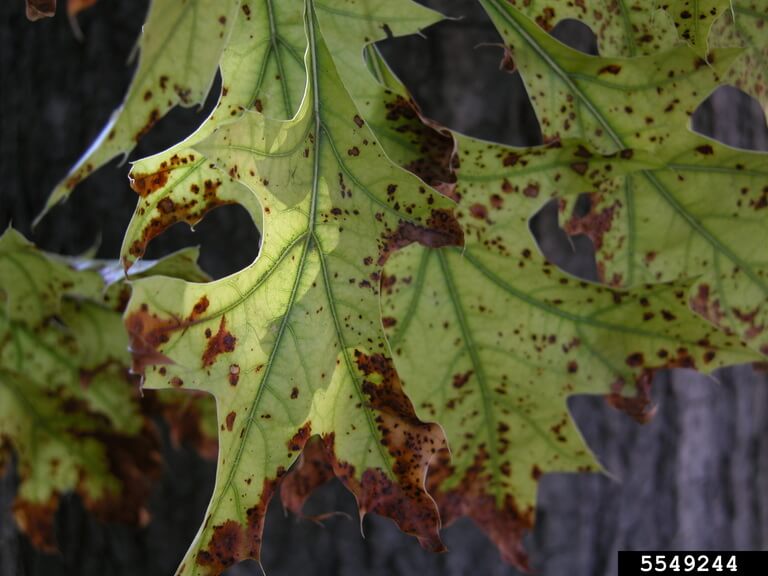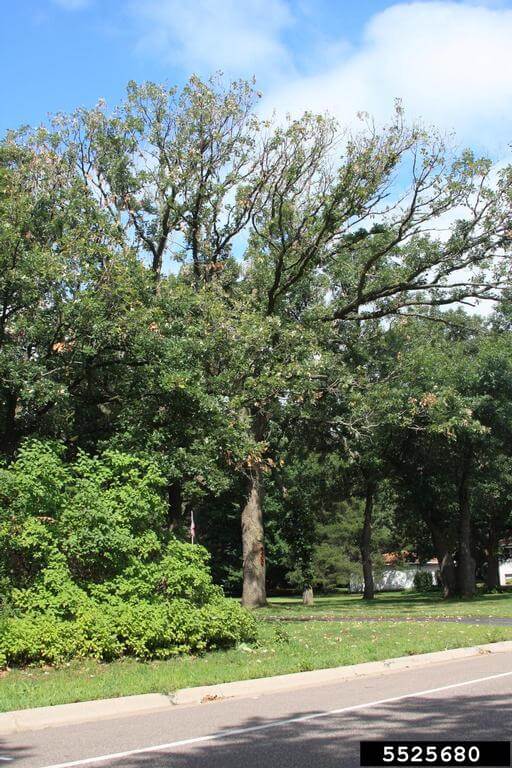If you’ve got a bur oak tree (Quercus macrocarpa) growing on your property, you likely already know that you’re a lucky homeowner! Bur oaks are majestic, towering trees that can provide shade in all seasons of the Midwest. Because of their thick and somewhat fire-resistant bark and drought tolerance, they have a natural ability to compete with native grasses. An iconic Midwest image is a wide-open prairie dotted with majestic oaks throughout.
Bur oaks are members of the white oak group (including white, chinquapin, swamp white, and post oaks). The oaks bear rounded lobes on their leaves and acorns, which mature in a single growing season. They can grow taller than 100 feet in elevation. A mature bur oak can grow 50-70 feet tall and live to be over 300 years old!
It’s also an adaptable tree due to its extensive root system. It can be found growing in moist areas and is well-suited to prairie and savanna soil, and clay soils and alkaline pH. Because of the dense foliage and large volume of leaves they shed, the bur oak dominates the field when you see this tree. However, a unique quality of oak and that of stress is it succumbs more often to various landscape diseases.
Unfortunately, over the last several decades, bur oaks have become susceptible to diseases and leaf blight. In this article, you’ll learn all about bur oak blight – how to identify it, how it’s different from oak wilt, and tree disease treatment and prevention options.

What Is Burr Oak Blight?
Bur oak blight is a fungal disease that started appearing in the Midwest in the 1990s. It’s caused by a native fungus that produces toxins, making bur oak leaves turn brown and eventually drop in late summer and early fall. This condition primarily affects the slow-growing bur oak variety of the oak tree.
Luckily, most bur oaks can survive being affected by this disease. The blight can cause up to 50% of their leaves each year to wilt and fall prematurely. However, the trees lose more than half of their leaves several years in a row, and it can become stressed. Stressed trees are also more susceptible to other diseases and insects, such as two-lined chestnut borer and Armillaria root rot.
How To Identify Bur Oak Blight
The symptoms of this disease start revealing themselves in mid-July in most areas. The signs include dark veins and the wilting of bur oak leaves on lower branches between the leaf veins. The disease starts at the bottom of the tree canopy and slowly proceeds upwards.
In late summer and early fall, the petioles (the part that joins the leaf to the stem) develop black pustules, forming small raised areas that can be seen upon close inspection. It is the presence of these black spots on the bur oak leaf that helps you confirm your tree has blight.
Affected leaves will remain on the tree during fall and winter, following strong winds. They can hold on until new leaves start growing in spring. These cycles continue annually, and the severity of the disease varies based on moisture levels in spring.
Your trees won’t show any signs of infection until up to two years after initial infection. The disease starts to spread throughout the tree’s canopy, repeating each year.

Bur Oak Blight vs. Oak Wilt
Because both are diseases that harm oak trees, there is often some confusion among homeowners about whether their trees have blight or oak wilt.
All oaks are susceptible to oak wilt; however, the red oak subgroup, including red, black, scarlet, and pin oaks, are more affected. Trees in this red oak group typically die quickly, usually within weeks or months after infection. Treatment will not save infected red oaks.
Oak wilt presents itself with leaf discoloration and rapid dieback. The disease is highly virulent and spreads rapidly through root grafts and beetle vectors.
Bur oaks are generally affected by blight slowly, and treatment can help manage the condition. It is less aggressive and typically affects the leaves, leading to browning and premature drop, but the trees can often survive with proper care.
How To Prevent & Treat This Tree Disease
Unfortunately, there aren’t any known preventions for bur oak blight at this time. Removing affected leaves from under the tree isn’t an effective strategy since the fungal spores live on the petioles that fall in late summer and remain active through winter.
Preventative treatment involves applying fungicides in spring before new leaves emerge and after leaves have fully expanded. This can help to reduce disease severity and improve tree health.
Since healthy trees are less susceptible to diseases, ensuring your trees are well-maintained and not stressed is crucial. Providing adequate water, mulching, and avoiding soil compaction can all help. Bur oaks thrive best in moist, well-drained soil, which helps them resist infections better.
If you suspect your bur oak has blight or another tree disease, it’s essential to have it inspected by a professional. Contact us to schedule a tree consultation and take the first step towards effective tree care.







